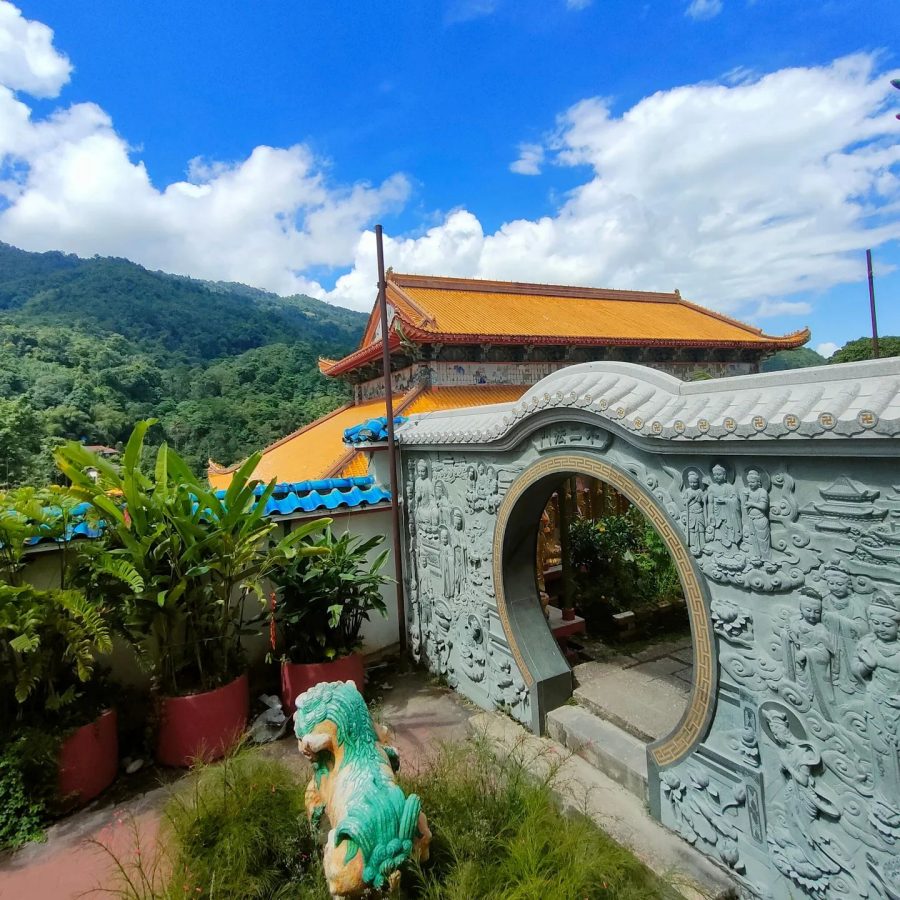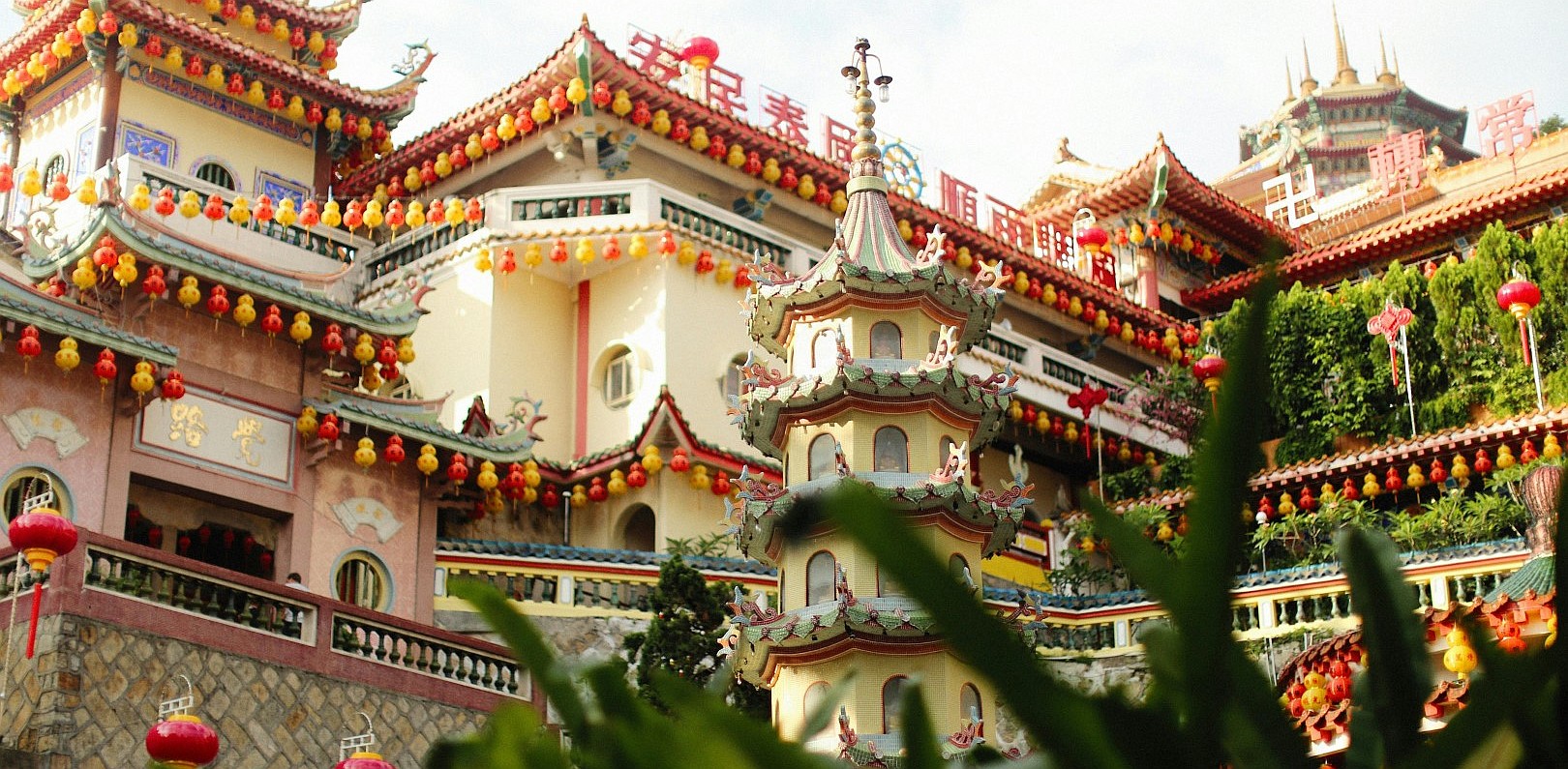From its towering Kuan Yin statue to its intricate pagodas, this iconic temple complex and historical marvel offers a journey of spiritual discovery and cultural insight.
Penang Hill’s monumental testament to a temple’s capacity for visual spectacle pretty much makes its way into any magazine that covers Penang. The entire length and breadth of Kek Lok Si is not only an architectural feat, but also a warm tribute to Penang’s cultural foundations. Some would also remember the temple complex for how it brims like a fairyland of lights during the 30-day Chinese New Year celebrations each year.
Lauded as one of the largest and oldest Buddhist temples in Southeast Asia, and built over a period of 40 years, this temple binds architectural intelligence, Chinese culture, and Buddhist devotion under one roof. The name Kek Lok Si translates to ‘Temple of Supreme Bliss,’ reflecting its role as a peaceful sanctuary. It’s no surprise that this establishment draws thousands of visitors and devotees each year.

Upon entering the suburb of Air Itam, you are bound to find signboards that lead you to Kek Lok Si. But halfway there, the imposing presence of the temple is visible as it sits seamlessly on the sprawling Crane Hill. You no longer need satellite navigation as the size of Goddess Kuan Yin, also known as the Goddess of Mercy, gets bigger as the destination gets closer. From the foothills of the temple, the urge to understand the cultural and historical insight extends to more active measures, in the form of carvings, sculptures and murals. The richness of colours and characters that spiral the way to the top adds even more to the temple’s atmosphere.

A PRIEST’S QUEST FOR SPIRITUAL EXCELLENCE
The history of the temple dates back to the late 19th century when a priest named Venerable Beow Lean arrived in Penang in 1885. His objective was to collect donations for the renovation of a monastery in Foochow, China. Unexpectedly, the trustees of the Kuan Yin Teng Temple in Pitt Street appointed him as their new resident priest. He was awestruck by the Penang Chinese’s devotion to Buddhism. After that, he ventured outside of George Town and spotted a sprawling hill in Air Itam and determined that it had the right feng shui to build a Buddhist monastery. Since then, the hill has been dubbed Crane Hill as the contour and terrain resemble a crane spreading its wings.
With the blessings of his superiors and generous contributions from the public, the temple began to take place in 1890. A total of 65 donors contributed to the construction, with the main five being Hakka tycoons. The temple’s first sections completed included the Hall of Bodhisattvas in 1891, followed by the Hall of Devas in 1895, the Hall of Devawira in 1896 and the Tower of Sacred Books in 1899. The first phase of the temple complex was completed in 1904, and at the same time, Venerable Beow Lean returned to China and paid homage to the Ching Emperor. The ruler presented him with 7,000 volumes of Buddhist sutras, which are still safely housed in the monastery’s library and royal scripts were converted into plaques and displayed in the temple.

LAYERS OF ARCHITECTURAL MARVEL
The 10-acre complex has three main sections: the Temple Ground, the Mid-Section, and the Hilltop, where the towering bronze Kuan Yin resides. Begin at the local market stalls where religious items such as incense sticks and lamps are sold. Further up, you’ll spot a long poem inscribed on a huge boulder by a famous scholar from the Tang Dynasty. Then, feed tortoises water spinach at the Liberation Pond, an act regarded as a good omen in Chinese culture.
Getting to the middle tier by foot demands a fair amount of walking along the unshaded, steep walkway and those wanting to avoid those huffs and puffs can hop on a funicular ride for a small fee. This centre point excels with a great deal of artistic flair. Think of flowering gardens guarded by sentinel sculptures, candles and giant urns filled with smouldering joss sticks gracing the entrance of prayer halls and clusters of yellow and red lanterns guiding through the hallways.

The maze of courtyards and corridors allows you to soak up the aesthetic details, but the second impressions of time-honoured carvings and paintings open up deeper into the sacred side of the narrative. Along the way, you will come across statues of the 12 zodiac animals. While there is plenty to see, what makes the landscape special is the walkable space of the beautifully curated gardens with ponds filled with koi fish and stone bridges.

MASSIVE ENDEAVOR OF THE KUAN YIN STATUE
Get your breath stilled for a moment underneath the 30.2-metre-tall statue of Kuan Yin at the third and final tier. From its base to the tip, the statue is comparable to the height of a 20-storey building. The statue was completed in 2002, but later a pavilion was added to shelter it. The pavilion’s roof is a three-tier pagoda held by 16 granite pillars elaborated with Chinese-style carvings. Each pillar consists of 40 cylindrical granite blocks, each with a thickness of 45 centimetres. The entire pavilion was built for RM40 million and inspired by the Temple of Heaven in Beijing, China. In December 2009, the consecration ceremony took place with 30,000 Buddhist Venerables of Mahayana, Theravada, and Vajrayana traditions.

The close view of the goddess in the octagonal pavilion seizes your attention and in doing so, it invites you to disarm any thoughts of ineptitude. Every intricate detail carved onto the structures, as well as the Terracotta-like Warriors in smaller sizes behind, has the trimmings you have envisioned of yesteryear grandeur. There are sculptures of two Dharma protectors named Heng and Ha. These Dharma protectors represent guardianship and protection in the Buddhist tradition, highlighting the spiritual importance of the Kek Lok Si temple.
It’s little-known that there was an older version of Kuan Yin, a white statue clothed in a blue robe. Venerable Bai Shen, the 4th Abbot of Kek Lok Si, worked on it for 12 years and in 1986, this version of Kuan Yin was unveiled. Unfortunately, the sculpture was made of fibreglass and didn’t cope well with Penang’s climate, and within three years, it began to disintegrate. The remains of the old statue that withstood the test of time are still available in the monastery’s area. Learning from the experience, the next abbot Venerable Da Neng, initiated a second attempt in 1990 to accomplish the aspiration of the previous Abbot. Three years later, the groundbreaking ceremony for the new sculpture marked the official start of the construction project.

CLUSTER OF BUDDHIST TRADITIONS
As much as the iconic statue is the centre of attraction, once you look beyond, the final tier has a lot more to offer. Walk around to take up the panoramic views of Air Itam, George Town, the Straits of Malacca and the lush rainforests of the island. Other note-worthy features include red circular gateways, dragon-shaped pillars and bell towers that pay homage to the unity between Mahayana and Theravada Buddhism. Mahayana, originating in the 1st century CE, is largely practised in China, Japan, and Korea. Theravada is seen as more orthodox and is prevalent in Southeast Asia, including Thailand, Myanmar, and Sri Lanka.

The Ten Thousand-Buddha Pagoda, also known as the Pagoda of Rama VI, is often said to be the finest example of cultural connection. It is said that King Rama VI from Thailand laid the foundation for it and it was later named after him. The tower comprises seven levels and the winding staircase to the top takes approximately five minutes, but it could take longer for those with the right eyes. The base of the pagoda represents the Chinese style, while the mid portions are Thai and the top binds the Burmese culture. Despite sharing the same spiritual values, one could see the artistic perspectives of each country. In fact, the outer structure and inner structure have different designs too. In the 1920s, this pagoda was the face of Air Itam.
Regardless of a person’s personal faith or cultural practices, tourism meshes with the popularity of the Kek Lok Si on a daily basis, yet that does not discount the temple’s aura. Simply put, a visit to this historical temple complex will enhance your cultural and historical understanding, and hopefully furnish you with a little of that bliss for which the temple is named.

"ExpatGo welcomes and encourages comments, input, and divergent opinions. However, we kindly request that you use suitable language in your comments, and refrain from any sort of personal attack, hate speech, or disparaging rhetoric. Comments not in line with this are subject to removal from the site. "



















